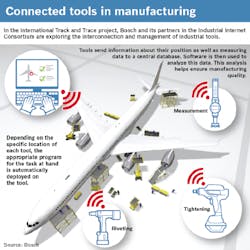Track and Trace Testbed: Integrating tools into manufacturing workflow and quality control
According to the IIC, the goal of the Testbed is to test concepts to manage handheld power tools in manufacturing and maintenance environments. In this context, management means not only knowing where every tool is and what it is doing but how it is being used. Thus, specific applications of torque, for example, will potentially be accessible in real-time as well as the exact location of the tool – alerting management to improper tool use and ensuring proper assembly of products. This capability can have immediate benefits in many industries, particularly in aerospace where very specific procedures and materials are required – and where detailed documentation is a must.
The Testbed is being spearheaded by IIC members Bosch, Cisco, National Instruments, and TechMahindra and moves manufacturing closer to the goal of full integration between manufacturing automation and human workers. The Consortium envisions eventual integration across the worlds of the factory floor, manufacturing execution systems (MES), enterprise resource planning (ERP) systems, and product lifecycle management (PLM).
The Testbed will be an interesting test case for the IIC, which was launched last year by a group of key industry players to help accelerate the growth of the Industrial Internet by providing an opportunity for organizations to work together to develop and test best practices. The consortium consortium approach has been widely applied in the information technology world for many years. Indeed, the IIC is managed on a day-to-day basis (and probably gets helpful suggestions from) the Object Management Group (OMG), which recently celebrated its 25th anniversary as an international, open membership, not-for-profit computer industry standards consortium. Several of OMG’s existing members, including MITRE, PrismTech, Real-Time Innovations, and Vanderbilt University also joined IIC, which is one of many initiatives currently shepherded by OMG.
For manufacturers, the Testbed is also an indication of how much change may be on the horizon; easily equivalent to the numerical control and factory automation waves of the late 20th century. The potential ubiquity and seamlessness of the Industrial Internet means it will likely impact an even wider range of organizations – not just large companies focused on mass production but smaller organizations or highly customized activities, too.
Drill Down
According to Richard Soley (of OMG and IIC), the Testbed will demonstrate the ability to detect anomalies in tool use and tool deployment as well as the ability to generate alerts. The system can also work with a “geofencing” system, something like the electronic fence that keeps Rover from wandering off your property. In this case, it keeps tools from getting lost and also makes sure they are in the right place and associated with the right task – so that workers don’t decide to simply “use a bigger hammer.”
Bosch is providing its Rexroth Nexo cordless, WiFi-enabled “nutrunner” for the effort. Also incorporated in the Testbed is the Bosch IoT Suite, which includes IoT middleware to support application development as well as security features and open standards for communication with individual devices.
One of the boldest goals of the Testbed is to move locational accuracy from around 100 centimeters currently to 30 centimeters, and eventually 5 centimeters!
It will be exciting to see what IIC and the Testbed achieve over the months ahead, their plans are certainly ambitious!
Alan R. Earls is a Boston-based writer focused on technology, business, and manufacturing — a field where he spent the earliest part of his career. He has written for publications and websites as diverse as The Boston Globe, Computerworld and Modern Infrastructure as well as Industry, The Manufacturer, and Today's Machining World.





